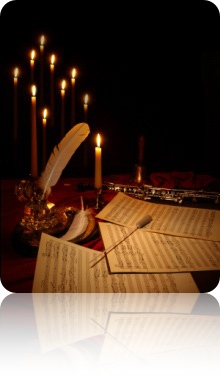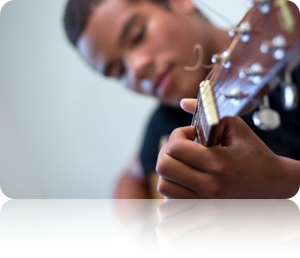Lesson 6: Form
Lesson 6: Form

Lesson 6: Form
Form
 Imagine that you are a composer. You’ve learned about the elements of pitch, rhythm, and dynamics. You have these aspects ready and you need to compose a particular piece of music. Now you are ready to deal with the form of music as you piece these elements together into something that is pleasing to the ear. In a way, it is like a building a house. Even if you have all of the materials in front of you, you still need to plan and carefully construct the structure of the building before you begin placing plaster, wood, and glass into the structure; in other words, you need to make sure that the structure doesn’t fall apart and that it will serve its purpose. Once the structure is in place, you can then create changes and additions that will set your building apart from others and give it a unique style. So it is with music.
Imagine that you are a composer. You’ve learned about the elements of pitch, rhythm, and dynamics. You have these aspects ready and you need to compose a particular piece of music. Now you are ready to deal with the form of music as you piece these elements together into something that is pleasing to the ear. In a way, it is like a building a house. Even if you have all of the materials in front of you, you still need to plan and carefully construct the structure of the building before you begin placing plaster, wood, and glass into the structure; in other words, you need to make sure that the structure doesn’t fall apart and that it will serve its purpose. Once the structure is in place, you can then create changes and additions that will set your building apart from others and give it a unique style. So it is with music.
Generally, form is referred to as the framework that a composer uses to create a piece of music. It is the combination of the other musical elements, including pitch, tempo, and dynamics. For example, a pop musician may use an alternating chorus and verse form. Each type or genre of music may have different forms that are commonly used and in fact, these forms may help define that particular genre. Composers can, and do, improvise and make changes to these forms to create new types or new sounds. However, the basic forms remain and are familiar starting points for music.
One area of form that composers and others can look at is the small phrases or series of notes that comprise one part of a piece of music. This may include both the music itself as well as the lyrics that are to be sung with the piece of music in this spot. For example, the 12-bar blues is a chord progression that is common in many popular forms of music. Essentially, this form of music indicates when a chord change will happen in the music. It may look something like this:
C C C C
F F C C
G F C C
In this case, the chord changes occur at the start of a bar of music so the musician would play four bars in the chord of C, before changing to F for two bars, and so on. Lyrics can also follow particular forms. One common form is the common meter, which consists of four lines of a particular number of beats that end in the rhyming pattern of a-b-a-b. This has been a common form for both ballads and hymns for quite some time. The form may sometimes have variations, such as a rhyming pattern that follows a-b-x-b, where the second and fourth lines rhyme, but the first and third do not. An example of the common meter can be found in the theme to the classic television series Gilligan’s Island:
Just sit right back and you'll hear a tale,
a tale of a fateful trip.
That started from this tropic port,
aboard this tiny ship.
The use of the common meter often means that different lyrics could be substituted easily within the music, since the same number of syllables would be used. Other examples of the common meter can be found in the popular hymn “Amazing Grace” and the Christmas carol “O Little Town of Bethlehem.”

In addition to the more minute parts of the music that a composer has to deal with, he or she also has to make decisions on a larger scale when dealing with form. For example, classical pieces may prescribe which instruments will be used to create the music in a performance or how many instruments will be used. Changing these prescriptions can create vastly different music than what the composer intended. Imagine, for example, that a classical piece designed for flutes and clarinets is played by a banjo and an accordion. The piece would likely have a different mood and feel with the change.
While there are many different forms that we may encounter when examining music, let’s take a look at a couple that have been common in history. A concerto is a musical piece in which one solo instrument (such as a piano or violin) is accompanied by an orchestra. Typically a concerto is structured into three different parts or movements. A sonata is a musical composition for a solo instrument (often piano or other keyboard instrument). In some cases, a composition may be called a sonata if it was designated as such by the composer rather than having the piece meet other criteria for a sonata. A symphony is a musical piece that has been scored for a full orchestra; it is often an extended composition. Many symphonies have four parts or movements, with the first movement in sonata form.
In this unit, we examined some of the basic elements that make up music. Although most of us are familiar with music in one form or another, we may not give a great deal of thought to the elements that combine to produce music. Having a basic understanding of these elements can help us better understand the similarities and differences among the genres of music. We can also better appreciate the elements that combine to produce some of our favorite pieces of music.
Think About
- What are the basic elements of music?
- What are pitch and melody? What do they add to music?
- What is rhythm? Why is rhythm important to music?
- What are dynamics in music? What are so of that way dynamics are noted?
- What is form in music? How do the other musical elements contribute to form?
Journal Activity: Answer these questions in your journal.